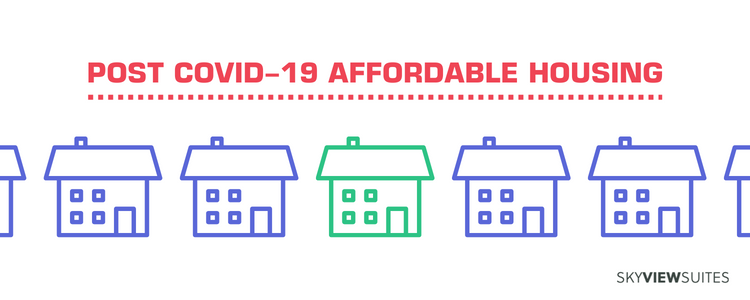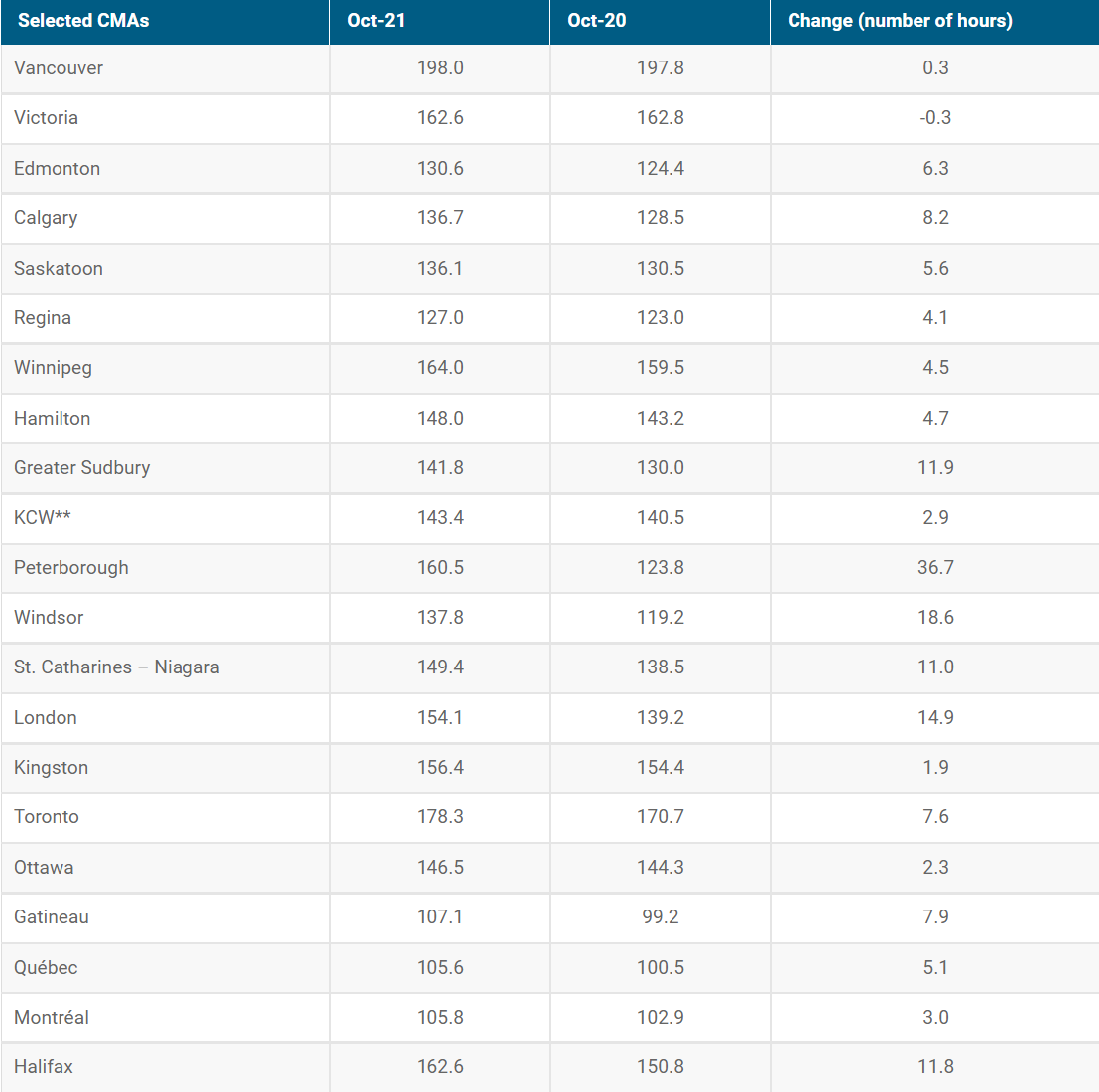
As the dust is starting to settle and the impact of COVID-19 on the rental markets and the economy in general is beginning to normalize, we decided to look back and see what effects (both temporary and permanent) the pandemic has had on the delicate dynamic between tenants and landlords in Toronto.
Statistics drawn from an article by CMHC show that “full-time employment equals 150 hours a month (or 37.5 hours a week), meaning [Central Metropolitan Areas] showing more than 150 hours implies the average rent is not affordable for a single average wage earner without another source of income, even if they work full time.” Toronto showed 170.7 hours in 10/20 and 178.3 hours in 10/21 indicating a 4.45% increase in just one year with projections to continue increasing.
Hours of work needed per month to keep monthly rent at 30% of gross income for a 2-bedroom purpose-built rental apartment3

While data on average rents, occupancy rates, etc is widely disseminated and relatively easy to interpret, we found that more “qualitative” insights of the sort we were looking for are a little harder to come by. We started by researching the situation prior to 2020, and realized that an important metric for us to measure and compare would be the rate of evictions over time.
Generally speaking, prior to the COVID-19 pandemic, our research indicated that relationships between landlords and tenants in Toronto were actually improving (on average). For example, a study published by the Wellesley Institute showed that the total number of formal evictions in Toronto stayed within a relatively stable range of 20,000 – 28,000 per year during the period of 2010 to 20181, with 2018 coming in at the lower end of that range.
Also, the number of rental properties in Toronto increased significantly during that time. This was in part due to a noticeable increase in rental-specific housing construction (apartment buildings), as well as a shift in the use of free-hold properties (mainly condos purchased by foreign investors) from owner-occupied to renter-occupied.
In short, while the number of evictions stayed the same in the years preceding the pandemic, the rental inventory in Toronto grew significantly. This means that the rate of evictions (as a percentage of total rental inventory) was actually decreasing – significantly.
We then tried to examine these same figures during the pandemic years (2020 and 2021), which is where things got a bit messy. First of all, the Ontario government paused residential evictions twice during the COVID-19 pandemic, which severely skewed the evictions figures. In the meantime, the amount of eviction applications skyrocketed. At one point, with so many Torontonians out of work due to COVID-19, it was estimated that as many as 11% of all renter households in the city were behind on their rent2.
It’s hard to determine the impact of these offsetting factors on the true eviction rate during the last couple of years. What we do know is that all of this has now resulted in a massive back-log at the Landlord Tenant Board. Combined with a major bounce-back of market rents in the city during recent months, this will likely lead to a lasting increase in eviction rates over the next several years.
This is because landlords who want to capture these market rent increases will find ways to do so, despite rent control rules and other regulatory protections for tenants. Landlords have become wise to work-arounds in tenancy laws. The three most common ways to avoid rent-control are all on the rise:
- “Personal Use” – this is where landlords declare that they (or their family members) are personally moving into the property. Tenants are then required to vacate, and often times later find the property relisted for rent at a much higher price.
- “Renovictions” – this is where landlords declare that they need their tenants to vacate in order to renovate. While the law does say that a landlord who requires a tenant to move out in order to perform renovations must subsequently offer that same property back to that tenant at the same rent they were paying before the renovations, few tenants are aware of this rule, and even fewer will take this up due to the additional cost of moving back. More recently, large-scale development-led evictions have been on the rise (apartment buildings being converted to condos, either via renovation or tear-down and rebuilt), exacerbating the issue.
- “Sale of Property” – when a rental property is listed for sale, if the new owner intends to live in the unit, the tenant is required to vacate. This is typically a legitimate scenario (where a landlord wants to take advantage of increased real estate prices), but that doesn’t give much consolation to the tenant who still has to move and is likely going to have to pay a much higher rent for a similar property elsewhere.
Once their “low”-rent paying tenants have vacated, landlords will find a way to get market rent, or they will simply take their units off the traditional rental market and list them on alternative markets (like the more lucrative furnished rental or short-term rental markets).
More regulation and enforcement might help tenants temporarily, but over the long run, history has shows us that they don’t work. Ultimately housing affordability comes down to simple economics – supply and demand. Headed towards this “new normal,” we will have to come to terms with our only sustainable solutions to the housing affordability issue in Toronto – we either slow down migration into the city (i.e. lower the demand) or find ways to encourage more rental inventory development (i.e. increase the supply).
The action plan as outlined in a report compiled by the City of Toronto, “Covid-19: Impacts and Opportunities,” includes direction for enhancing eviction prevention measures and efforts for increasing supply through the creation of 40,000 affordable rental and supportive homes.
“We must prepare for many people who have lost their jobs and who are behind in their rent to be supported to live (financially), to look for work and to prevent evictions from their housing. This is a top priority” – Comment from the City Consultation
While the city’s plans are in their beginning stages to remedy and accommodate the lasting effects of Covid-19 on affordable housing, statistics show that residents are opting to live in the
suburbs as the demand for larger housing has grown and working from home has become more prevalent.
1 https://www.wellesleyinstitute.com/wp-content/uploads/2020/08/Forced-Out-Evictions-Race-and-Poverty-in-Toronto-.pdf
2 https://www.wellesleyinstitute.com/wp-content/uploads/2020/08/Forced-Out-Evictions-Race-and-Poverty-in-Toronto-.pdf
3 https://www.cmhc-schl.gc.ca/en/media-newsroom/news-releases/2022/rental-markets-continue-recovery-covid-19-disruptions